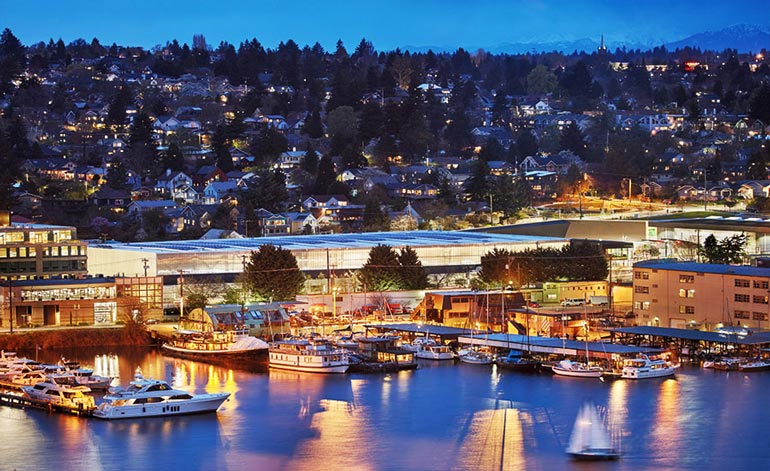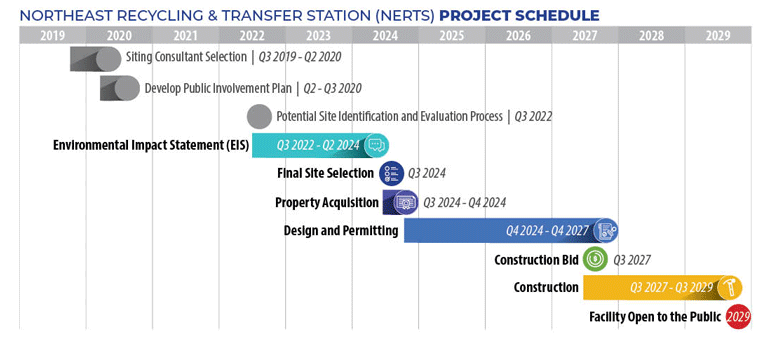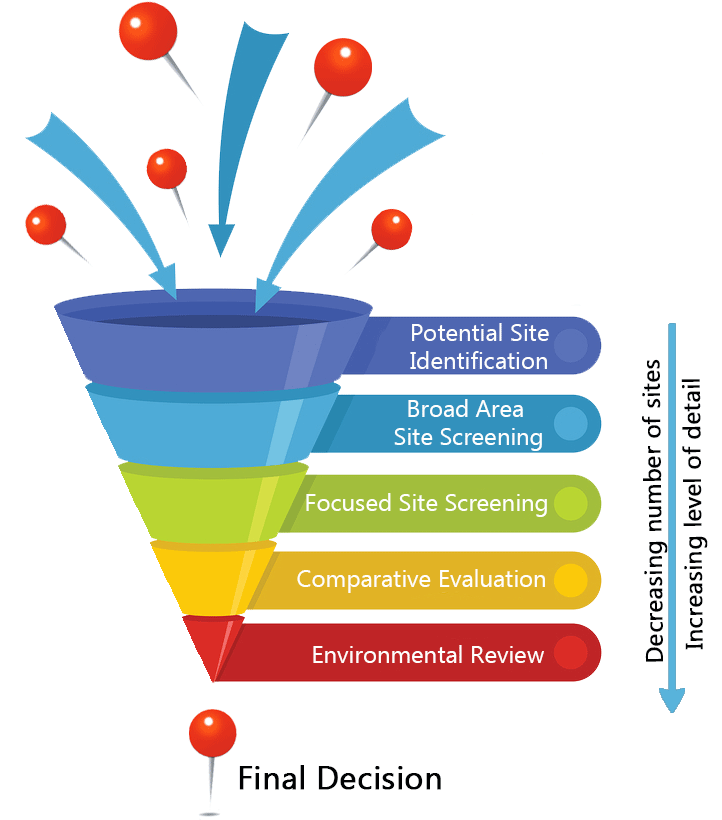Northeast Recycling & Transfer Station SEPA overview
Welcome to the Northeast Recycling and Transfer Station SEPA overview page. This page shares information on the SEPA (State Environmental Policy Act) process for the project’s Final Environmental Impact Statement (FEIS) and Draft Environmental Impact Statement (EIS). These documents contain studies of three potential site alternatives and a no-action alternative for the future Northeast Recycling and Transfer Station (NERTS).
King County announces new Northeast Recycling & Transfer Station in Kirkland
The new Northeast Recycling & Transfer Station (NERTS) will replace the aging Houghton Transfer Station and provide expanded waste disposal and recycling services, while reducing environmental impacts, to serve the growing communities of northeast King County. Read more here.
Project introduction
Replacing the Houghton station will make recycling, food, and yard waste disposal more convenient and accessible and will help keep reusable materials out of the landfill.
Wherever it is located, a new Northeast Recycling & Transfer Station will have fewer impacts than the current Houghton station.
King County transfer stations are where residents, businesses, and waste haulers bring garbage, yard waste and recyclable materials. Currently, trash and recycling haulers, residents, and businesses within northeast King County use the Factoria and Houghton transfer stations to dispose of these items. After disposal, garbage is taken to the Cedar Hills Regional Landfill, recyclable materials are trucked to private companies and made into new products, and yard waste is taken to Cedar Grove where it is converted into compost.
The Houghton Recycling & Transfer Station in Kirkland is one of the Solid Waste Division’s busiest transfer stations, but it lacks many services and has outlived its useful life. Because of this, the need for a new station was identified in the 2019 Comprehensive Solid Waste Management Plan, which was adopted by 24 cities and the Washington State Department of Ecology.
Needs and benefits
Wherever it is located, the new Northeast Recycling and Transfer Station will actually have fewer impacts than the current Houghton Station.
- Trash compacting equipment will make hauling more efficient and reduce the number of commercial trucks needed to move garbage to the landfill. It will also reduce greenhouse gas emissions and vehicle exhaust.
- A new station would be built to the latest environmental standards, featuring green design certifications to reduce energy consumption and emissions.
- A new station will be enclosed and equipped with technology to control dust and odors.
- In line with King County’s Re+ efforts, a new station would offer food and yard waste disposal, where it can be diverted from the landfill and turned into compost and used to enrich soil throughout King County. Because methane generated from food and yard waste is a leading greenhouse gas contributor, finding ways to divert it from the landfill is one of our top priorities.
- A new station would include environmental improvements such as wetlands/habitat enhancements and creek daylighting to offset any impacts identified in the EIS that may happen at the site once it's built. This is called mitigation and improvements will vary depending on which site is selected. Examples of other mitigation measures on county capital projects include roadway or sidewalk improvements, recreation opportunities such as trail enhancements or play areas, environmental education and community meeting space, and enhanced architectural features such as bioswales.
- A new, modern station closer to your business would make recycling and waste disposal more convenient for you and your suppliers and vendors.
Learn more about this project

A transfer station is a facility at a central location where garbage can be hauled and disposed of prior to being transported to our Cedar Hills Regional Landfill. Recycling can also be dropped off and sorted before being picked up by recycling processors. Before modern design advances, transfer stations were often called dumps. Modern stations offer newer technology such as noise and odor control and community amenities.
Our newer facilities are enclosed to contain airflow and odors. We install dust and odor control and odor-eating enzymes can be added to reduce the smell even further. Our modern stations are walled in with sound barriers to further contain noise. We add more space for garbage compactors to help reduce the number of truckloads that are sent to the landfill daily. We also add additional lanes to allow vehicles to pull into line on station property, instead of backing onto neighborhood streets.
Modern stations are designed to fit the feel of their neighborhood and reflect their surroundings. Buildings can look like business facilities or even community centers and offer neighborhood amenities. While NERTS is in design, we will continue to work with the community and share updates on the project at key milestones.
2019: Comprehensive Plan
To meet the region's growing demand for environmentally responsible waste management services, King County's Solid Waste Division plans to site, design, and build a modern transfer station in northeast King County. The need for a new station was identified in the 2019 Comprehensive Solid Waste Management Plan, which was adopted by 24 cities and the Washington State Department of Ecology.
Fall 2019: Project Kickoff/Siting begins
King County Solid Waste Division began meeting with the Kirkland, Redmond, Sammamish, Woodinville and Unincorporated King County representatives. This group was called the Core Cities and worked together to develop siting criteria based on 2006 Solid Waste Transfer and Waste Export System Plan, the South County Recycling and Transfer Station project, and feedback from northeast county stakeholders.
October 2020: Siting Advisory Group Convened
In the fall of 2020, the project team recruited community representatives for the Siting Advisory Group (SAG), a community-based group that advised King County on where to site the new station and what to consider while making that decision. To ensure wide representation, the SAG was comprised of both appointed and at-large seats. Appointed seats were held for specific interests and organizations, and at-large seats were filled by community members through an application process.
Members of the SAG met regularly to learn about the siting process and provide their insights to the County. As part of their role, SAG members were expected to share information about the process with their communities, listen to community concerns and hopes, and share feedback they received with the County throughout the site selection process.
July 2022: King County Solid Waste Action
King County Solid Waste Division identified three alternatives and a no action alternative to study in the Draft EIS:
- A site composed of six properties in the 15000 block of Woodinville-Redmond Rd NE in Woodinville
- The current Houghton Transfer Station property at 11724 NE 60th St in Kirkland
- The Houghton Park and Ride property at 7024 116th Ave NE in Kirkland
November 2022 to January 2023: SEPA Scoping Period
Based on the results of the siting process, the Solid Waste Division recommended three alternative sites – two located in Kirkland and one in Woodinville. During the Scoping comment period, residents, businesses, Tribes, and other public agencies had the opportunity to share their thoughts and provide recommendations on areas of evaluation for the Solid Waste Division and its consultants to take into account when developing the Draft Environmental Impact Statement.
February 2023: King County SWD Removes Houghton Park and Ride
After receiving new information about planned development on a portion of the Houghton Park and Ride property, King County removed the site as a candidate for further analysis in the Environmental Impact Statement (EIS) for the Northeast Recycling and Transfer Station Project.
The current property owner, WSDOT, has plans for infrastructure improvements that will require about 25% of the north portion of the park and ride. Though WSDOT plans to surplus the rest of the parcel, the remaining available area would have been too small to adequately accommodate a transfer station with the levels of service needed for this growing part of the service area.
March – April 2023: Revised SEPA Scoping Period
King County issued a revised scoping notice and held an additional 21-day public comment period to give agencies, tribes, and the public an opportunity to provide comments on the removal of the Houghton Park and Ride.
April 2023 to February 2024: SEPA Draft EIS
King County prepared a Draft EIS under SEPA for NERTS, which assessed two potential site alternatives and a no action alternative for siting the Northeast Recycling and Transfer Station. The following elements were included as part of that review:
- Earth
- Air
- Water
- Hazardous Materials
- Wetlands
- Vegetation, Fish, and Wildlife
- Energy and Natural Resources
- Environmental Health
- Land and Shoreline Use
- Noise
- Aesthetics, Light, and Glare
- Historic and Cultural Resources
- Transportation
- Public Services and Utilities
February 2024 to April 2024: Draft EIS Public Comment Period
Following the publication of the Draft EIS, tribes, agency partners, jurisdiction stakeholders, social service providers, community organizations, and the general public were invited to comment on the document and its findings.
Schedule/timeline

What’s next?
- Q3 2025 to Q3 2027: Design and Permitting
- 2027 to 2029: Construction
- 2029: New Recycling & Transfer Station Opens
Environmental review
Enacted in 1971, the State Environmental Policy Act (SEPA) is a law that requires state and local agencies to identify the potential environmental impacts of proposed actions and plans through a formal review process. When potentially significant impacts are anticipated, an Environmental Impact Statement (EIS) is required.
An EIS is a planning tool in the decision-making process to identity potentially significant environmental impacts, unavoidable impacts, mitigation measures, as well as indirect, cumulative, and construction-related impacts. An EIS does not authorize a specific action, nor does it recommend for or against a particular course of action.
Environmental impacts to be analyzed could include such things as Noise, Odor, Surface Water, Wildlife, Human Health, Transportation, and others relevant to the specific project and location. The SEPA review process is designed to help agency decision-makers and the public understand how a proposed action will affect the environment.
What is Scoping?
An EIS has several steps. The first is called “scoping.” Scoping identifies all the potential environmental impacts of a public agency decision, development, or project, like this one. Scoping helps narrow down and focus which significant environmental issues SWD will study. SWD identified alternatives and will evaluate how impacts will be addressed.
What is a Draft Environmental Impact Statement (DEIS)?
The alternatives are then examined in a draft EIS(DEIS). The DEIS is distributed to public agencies (state, regional, city) and tribes, organizations, and the public for a review and comment period. Public hearings are held following the issuance of a DEIS, to gather comments regarding the alternatives.
What is a Final EIS?
The final EIS (FEIS) is the third and final part of the EIS process. After analyzing public comments and any additional information, an FEIS is issued. This document helps guide a final siting decision.
SEPA requires agencies to consider a range of alternatives that meet the goals of their proposed plans. These include the proposed action alternatives and a no action alternative, which looks at the impact of maintaining the status quo. Alternatives are important because they allow decision makers and the public to compare the merits and impacts of different choices.
A proposal may include actions to avoid, reduce, repair, minimize, and/or monitor impacts. These types of actions are called mitigation. An example would be designing a project to avoid sensitive habitat such as a wetland, or replanting trees and shrubs to restore disturbed areas after a project is completed.
SEPA requires agencies to consider a range of alternatives that meet the goals of their proposed plans. These include the proposed action alternatives and a no-action alternative, which looks at the impact of not taking action, or the status quo. Alternatives are important because they allow decision-makers and the public to compare the merits and impacts of different choices.
A proposal may include actions to avoid, reduce, repair, minimize, and/or monitor impacts—this is mitigation. An example would be designing a project to avoid sensitive habitat such as a wetland, or replanting trees and shrubs to restore disturbed areas after a project is completed.
Alternatives
Scroll through this section to learn about key features and impacts for each of the alternatives that were studied. The site for Alternative 1 is located at 11724 NE 60th Street in Kirkland. Alternative 1 included two options:
- Alternative 1A
A facility constructed after the existing transfer station building is closed and demolished; and - Alternative 1B
A facility constructed while the existing transfer station building is open and operating, and then closed and repurposed or replaced after the new station is open. - Alternative 2
The site for Alternative 2 – Woodinville is located on six tax parcels in the 15000 block of Woodinville-Redmond Road NE in Woodinville on parcels 1526059086, 5711600010, 5711600020, 5711600030, 1526059094, and 1526059095. - No Action Alternative
Under the No Action Alternative no changes would be made to the current Houghton Transfer Station.
Addendum to the Final EIS
Final EIS
- Section 0: Final EIS Summary
- Section 1: Introduction and Background
This section includes the Final EIS table of contents, fact sheet, executive summary, and introduction and background. - Section 2: Alternatives
This chapter reviews and summarizes the alternatives studied in the EIS. - Section 3: Affected Environment, Potential Environmental Impacts, Mitigation Measures, and Significant Unavoidable Adverse Impacts
This chapter is broken out into each environmental element and includes a summary of the analysis for each alternative. - 3.1 Earth
- 3.2 Air
- 3.3 Water
- 3.4 Hazardous Materials
- 3.5 Wetlands
- 3.6 Vegetation, Fish, and Wildlife
- 3.7 Energy and Natural Resources
- 3.8 Environmental Health
- 3.9 Land and Shoreline Use
- 3.10 Noise
- 3.11 Aesthetics, Light, and Glare
- 3.12 Historic and Cultural Resources
- 3.13 Transportation
- 3.14 Public Services and Utilities
- Sections 4-7
References, distribution lists, glossary, authors - Appendices
- Appendix A: Air Assessment
- Appendix B: Water Assessment
- Appendix C: NERTS Hazardous Materials Assessment Part 1
- Appendix C: NERTS Hazardous Materials Assessment Part 2
- Appendix D: Critical Areas Assessment
- Appendix E: Noise Assessment
- Appendix F: Visual Assessment Part 1
- Appendix F: Visual Assessment Part 2
- Appendix G: Cultural Assessment
- Appendix H: Transportation Assessment Part 1
- Appendix H: Transportation Assessment Part 2
- Appendix I: Reasonably Foreseeable Future Projects
- Appendix J: List of Birds for Bridge Trails
- Appendix K: NERTS Siting Summary
- Appendix L: DEIS Comment Responses
- Appendix M: Fuel Use Assessment
- Appendix N: List of Birds for Sammamish River Trail
Draft EIS
For a more detailed overview of the assessment, please explore the Draft EIS Executive Summary (also available in Spanish, Simplified Chinese, and Hindi). You can also dive deeper by jumping into the full Draft Environmental Impact Statement. Both the Executive Summary and full Draft EIS are available as a downloadable PDF. Please contact us at northeast@kingcounty.gov or 206-477-4466 if additional accessibility resources are required.
- Section 1: Introduction and Background
This section includes the DEIS table of contents, fact sheet, executive summary, and introduction and background. - Section 2: Alternatives
This chapter reviews and summarizes the alternatives studied in the DEIS. - Section 3: Affected Environment, Potential Environmental Impacts, Mitigation Measures, and Significant Unavoidable Adverse Impacts
This chapter is broken out into each environmental element and includes a summary of the analysis for each alternative. - 3.1 Earth
- 3.2 Air
- 3.3 Water
- 3.4 Hazardous Materials
- 3.5 Wetlands
- 3.6 Vegetation, Fish, and Wildlife
- 3.7 Energy and Natural Resources
- 3.8 Environmental Health
- 3.9 Land and Shoreline Use
- 3.10 Noise
- 3.11 Aesthetics, Light, and Glare
- 3.12 Historic and Cultural Resources
- 3.13 Transportation
- 3.14 Public Services and Utilities
- Section 4-7
References, distribution lists, glossary, authors - Appendices
- Appendices A & B: NERTS Air Quality and Greenhouse Gas Assessment and Water Resources Assessment
- Appendix C: NERTS Hazardous Materials Assessment
- Appendices D & E: NERTS Critical Areas Assessment and Noise Assessment
- Appendices F & G: NERTS Visual Impact Assessment and Cultural Resources Assessment
- Appendix H: NERTS Transportation Assessment – Part 1
- Appendix H: NERTS Transportation Assessment – Part 2
- Appendices I & J: Reasonably Foreseeable Future Projects in the Study Areas and List of Birds for Bridle Trails State Park
- Appendix K: Siting Summary Report
Thank you
Thank you for engaging with the NERTS project during the SEPA process! We look forward to continuing to work with the public as we move forward in the next steps of the siting process. Please continue to check the project website regularly for updates on our progress.

 Translate
Translate
